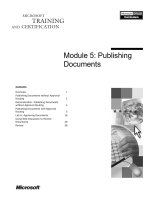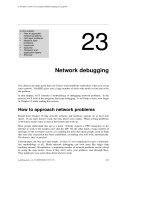Tài liệu Chapter 5 Data Encoding docx
Bạn đang xem bản rút gọn của tài liệu. Xem và tải ngay bản đầy đủ của tài liệu tại đây (213.5 KB, 45 trang )
William Stallings
Data and Computer
Communications
Chapter 5
Data Encoding
Encoding Techniques
Digital data, digital signal
Analog data, digital signal
Digital data, analog signal
Analog data, analog signal
Digital Data, Digital Signal
Digital signal
Discrete, discontinuous voltage pulses
Each pulse is a signal element
Binary data encoded into signal elements
Terms (1)
Unipolar
All signal elements have same sign
Polar
One logic state represented by positive voltage the
other by negative voltage
Data rate
Rate of data transmission in bits per second
Duration or length of a bit
Time taken for transmitter to emit the bit
Terms (2)
Modulation rate
Rate at which the signal level changes
Measured in baud = signal elements per second
Mark and Space
Binary 1 and Binary 0 respectively
Interpreting Signals
Need to know
Timing of bits - when they start and end
Signal levels
Factors affecting successful interpreting of
signals
Signal to noise ratio
Data rate
Bandwidth
Comparison of Encoding
Schemes (1)
Signal Spectrum
Lack of high frequencies reduces required bandwidth
Lack of dc component allows ac coupling via
transformer, providing isolation
Concentrate power in the middle of the bandwidth
Clocking
Synchronizing transmitter and receiver
External clock
Sync mechanism based on signal
Comparison of Encoding
Schemes (2)
Error detection
Can be built in to signal encoding
Signal interference and noise immunity
Some codes are better than others
Cost and complexity
Higher signal rate (& thus data rate) lead to higher
costs
Some codes require signal rate greater than data
rate
Encoding Schemes
Nonreturn to Zero-Level (NRZ-L)
Nonreturn to Zero Inverted (NRZI)
Bipolar -AMI
Pseudoternary
Manchester
Differential Manchester
B8ZS
HDB3
Nonreturn to Zero-Level (NRZ-L)
Two different voltages for 0 and 1 bits
Voltage constant during bit interval
no transition I.e. no return to zero voltage
e.g. Absence of voltage for zero, constant
positive voltage for one
More often, negative voltage for one value and
positive for the other
This is NRZ-L
Nonreturn to Zero Inverted
Nonreturn to zero inverted on ones
Constant voltage pulse for duration of bit
Data encoded as presence or absence of signal
transition at beginning of bit time
Transition (low to high or high to low) denotes a
binary 1
No transition denotes binary 0
An example of differential encoding
NRZ
Differential Encoding
Data represented by changes rather than levels
More reliable detection of transition rather than
level
In complex transmission layouts it is easy to lose
sense of polarity
NRZ pros and cons
Pros
Easy to engineer
Make good use of bandwidth
Cons
dc component
Lack of synchronization capability
Used for magnetic recording
Not often used for signal transmission
Multilevel Binary
Use more than two levels
Bipolar-AMI
zero represented by no line signal
one represented by positive or negative pulse
one pulses alternate in polarity
No loss of sync if a long string of ones (zeros still a
problem)
No net dc component
Lower bandwidth
Easy error detection
Pseudoternary
One represented by absence of line signal
Zero represented by alternating positive and
negative
No advantage or disadvantage over bipolar-AMI
Bipolar-AMI and Pseudoternary
Trade Off for Multilevel Binary
Not as efficient as NRZ
Each signal element only represents one bit
In a 3 level system could represent log
2
3 = 1.58 bits
Receiver must distinguish between three levels
(+A, -A, 0)
Requires approx. 3dB more signal power for same
probability of bit error
Biphase
Manchester
Transition in middle of each bit period
Transition serves as clock and data
Low to high represents one
High to low represents zero
Used by IEEE 802.3
Differential Manchester
Midbit transition is clocking only
Transition at start of a bit period represents zero
No transition at start of a bit period represents one
Note: this is a differential encoding scheme
Used by IEEE 802.5
Biphase Pros and Cons
Con
At least one transition per bit time and possibly two
Maximum modulation rate is twice NRZ
Requires more bandwidth
Pros
Synchronization on mid bit transition (self clocking)
No dc component
Error detection
Absence of expected transition
Modulation Rate
Scrambling
Use scrambling to replace sequences that would
produce constant voltage
Filling sequence
Must produce enough transitions to sync
Must be recognized by receiver and replace with
original
Same length as original
No dc component
No long sequences of zero level line signal
No reduction in data rate
Error detection capability
B8ZS
Bipolar With 8 Zeros Substitution
Based on bipolar-AMI
If octet of all zeros and last voltage pulse
preceding was positive encode as 000+-0-+
If octet of all zeros and last voltage pulse
preceding was negative encode as 000-+0+-
Causes two violations of AMI code
Unlikely to occur as a result of noise
Receiver detects and interprets as octet of all
zeros
HDB3
High Density Bipolar 3 Zeros
Based on bipolar-AMI
String of four zeros replaced with one or two
pulses
B8ZS and HDB3









